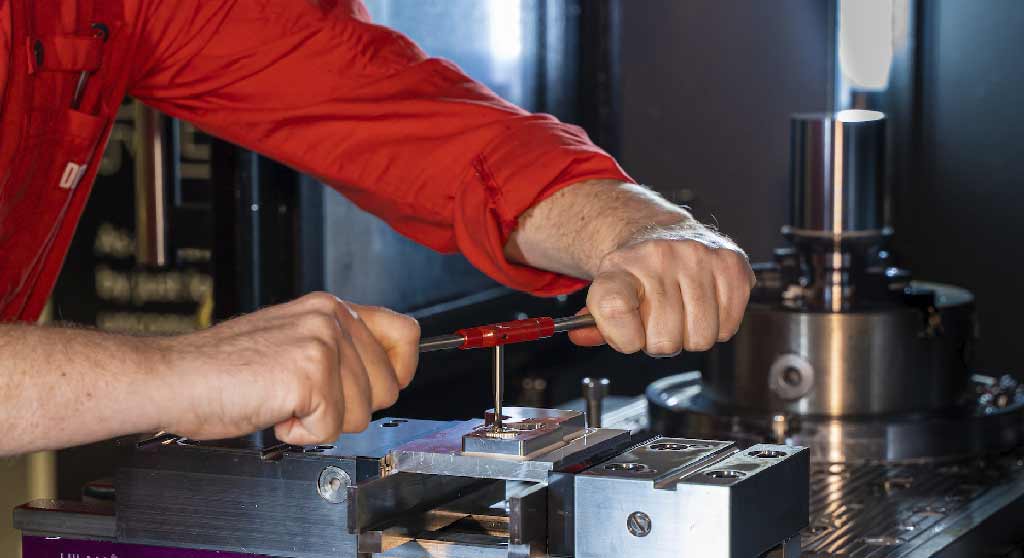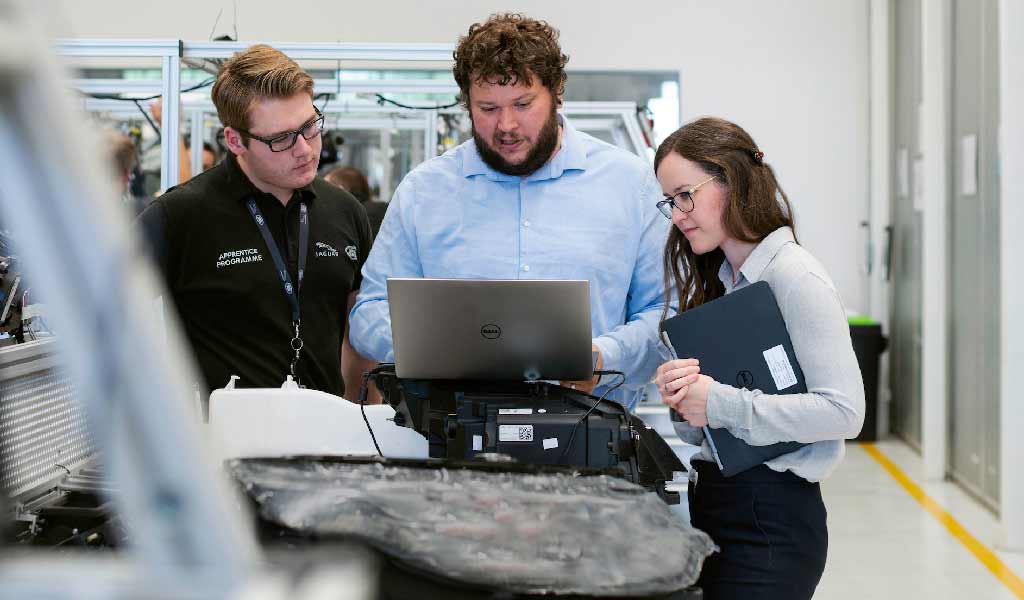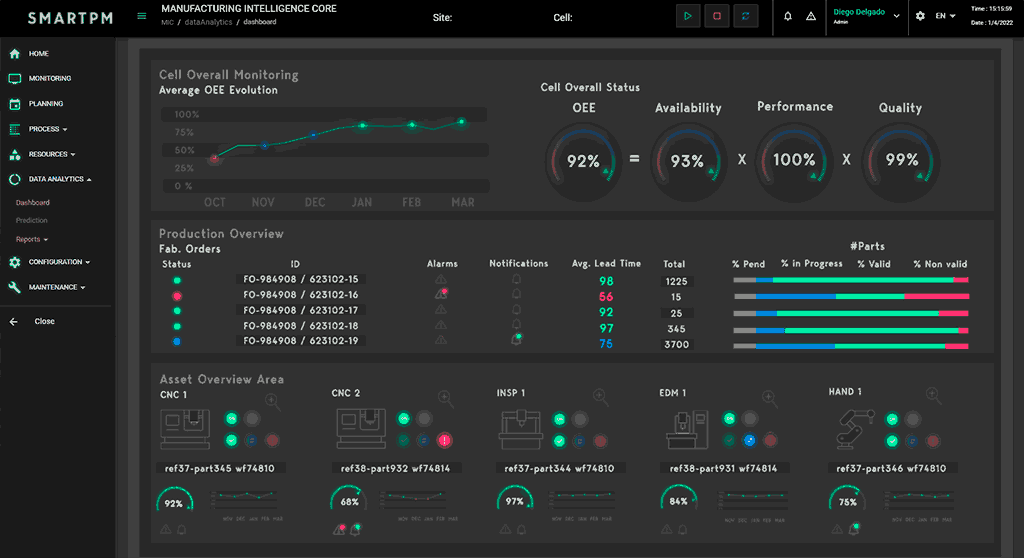Benjamin Franklin, to whom some sources attribute the phrase «time is money», used to say that all the time that could be spent working was time well spent.
We suppose that if he was here today, he would have to adapt his reasoning to the new times, since nowadays what we are looking for is not to work more but work better, i.e., do more in less time, using fewer resources and energy and generating less waste.
Translating this to the machining industry, the challenge faced by the companies is the following: How to reduce overall production lead time while maintaining quality and making better use of the resources available?

Manufacturing lead time, productivity and OEE
In the 60s and 70s the focus of production processes was on cost efficiency. In the 80s on quality and zero defects. Yesterday on speed and delivery times. Today all these factors are still crucial and that is why we place the focus on the OEE (Overall Equipment Effectiveness).
The OEE indicator measures the overall effectiveness of production equipment and summarises productivity, quality and resource utilisation. Having this more integrative approach to productivity makes it easier for workshops to really move towards effective continuous improvement, avoiding improving some parameters at the expense of others. For example, it prevents us from reducing lead times at the expense of quality.
The trend in industrial production towards manufacturing shorter and more customised series requires flexible infrastructure and processes. Being able to produce with reduced lead times and making the most of resources to do more with less – lean manufacturing – is the essence of OEE.
OEE is one of the most important KPIs in the manufacturing industry and its optimisation is a priority for most companies.
What is exactly OEE?
As we mentioned, OEE stands for Overall Equipment Effectiveness and is a productivity indicator that measures quality, performance and availability. Although depending on the industry its interpretation can be nuanced, in general this indicator is calculated as follows:
quality indicates the percentage of good parts produced; performance is the ratio between planned and executed cycle times (i.e., how close production has come to the plan in terms of speed); and availability reflects the frequency and duration of stoppages.
It is one of the most important KPIs in the manufacturing industry and its optimisation is a priority for most companies. Improving OEE means reducing the time from the start of a production process to completion (and delivery to the customer), while maintaining quality and improving resource utilisation.
The essence of OEE is to be able to produce in less time and make the best use of resources.
How can this be achieved? Here are some ideas.
5 strategies to reduce production lead time and thus improve OEE

Reducing lead time in industrial production involves optimising times in all stages up to the order delivery, affecting processes and assets throughout the value chain that we will have to manage intelligently to achieve better outcomes.
1. Optimisation of production processes and downtime
Optimising operations requires assessing every process involved in production, including the main enemies of productivity: unscheduled downtime and reworking of defective parts or to complete unfinished activities.
Unscheduled stops can be caused by breakdowns or failures in the internal organisation, e.g. a lack of certain materials or responsible personnel. Since a machine stop can bring the entire production process to a halt, it is important to keep it under control.
Therefore, maintenance plays a crucial role, since carrying it out in an intelligent way will allow you to have the machines working in the periods you have scheduled. It is also essential to visualise the causes behind these inefficiencies. This way you can find structural solutions to the underlying problems that lead to these unscheduled stops or reprocessing, instead of using patches or temporary solutions.

2. Real-time visibility of what happens in the process
A major part of keeping lead time under control is having real-time visibility over processes. We’ve discussed the benefits of real-time visibility in our blog before, so here we will just highlight a couple of ideas.
- Having a system that provides information on the time required for each process allows you to estimate and manage deadlines for your customers.
- This system also offers greater flexibility when it comes to reorganising work or introducing last-minute changes, enabling a reallocation of tasks to meet urgent orders, changes or modifications, etc.
Intelligent automation reduces shop floor lead time and facilitates production planning.
3. Dynamic shop floor resource management
Closely related to the previous point, the possibility of «viewing» in real time allows for a more dynamic planning of resources (people, machines, etc.), contributing to optimise times.
Being able to have a real-time image of where you are with respect to production targets and each machine performance leads to improved organisation’s precision. For example, it enables troubleshooting inefficiency problems without the need to wait for paper reports the next day.
This is even more important when you have critical assets in terms of productivity or that can generate bottlenecks Monitoring the efficiency and safety of these assets benefits the entire production line, as critical machine downtimes can impact other processes and equipment in other locations.
4. Production set-up and changeover time
As we told you in this interview, it is essential to take setting-up times into account in production management. Although it seems obvious, many organisations still overlook this.
What tends to happen is this: when set-up times are long, the criterion of many professionals is to change the schedule because it seems more efficient to group jobs that share the same configuration, even if their delivery deadlines are different. This inevitably affects delivery deadlines and therefore lead time.
5. Facilitating the culture of innovation
Continuous improvement requires dedication. Teams need to have time to acquire new skills, such as operating new machines or thinking about how to improve processes, to facilitate this continuous improvement and therefore the possibility of improving lead times in the medium and long term.
For this to happen there has to be an organisational culture that facilitates it, taking this into account and avoiding overloading machines (and workers) up to 100% or leaving innovation «for when there is free time»
The return that this can bring is undoubtedly very positive for the organisation, on the one hand with increased productivity that allows higher profits, and with a reduction in both direct (defective) and indirect costs (absenteeism and labour unrest), on the other.
Benefits of controlling lead time
The benefits of controlling and reducing lead time for companies include:
- improved inventory management and potential to move towards a just-in-time supply chain model;
- improved cash-flow, cutting time between the purchase and sale of products, thus reducing stock costs;
- greater flexibility to adapt to changes on the market; and
- increased responsiveness and shorter delivery times, which improves competitiveness.
In SMARTPM we help you to generate more value.
As we said at the beginning of this article, reducing lead time means delivering sooner thanks to smarter work processes. Shorter lead times are a major competitive advantage and should be one of the priorities of any organisation.
Intelligent automation will allow you to reduce lead time on your shop floor and make production planning easier. Do not hesitate to contact our engineering and process automation experts.
Header photo: Daniel Smyth-Pexels | Photo engineers: ThisIsEngineering-Pexels
